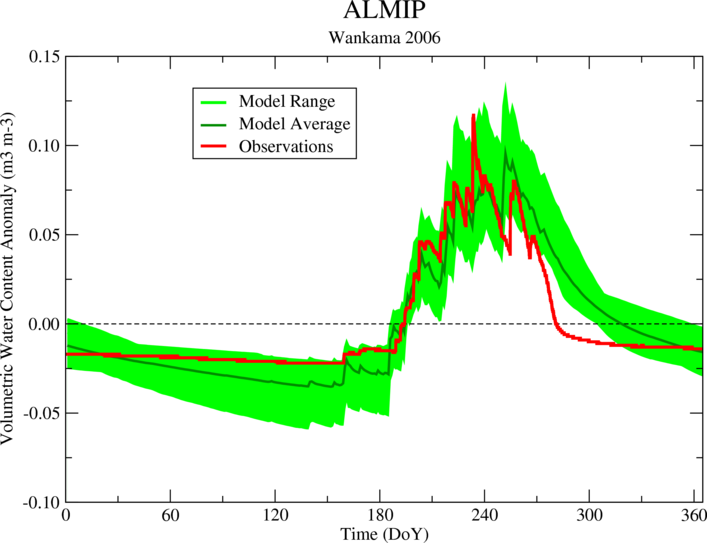Comparison with field measurements
Several ALMIP model evaluation efforts are underway. As an example,
a comparison of
the daily average ALMIP simulated volumetric water content (from Exp.3: i.e. using the atmospheric state variables from ECMWF, the downwelling radiative fluxes from LAND-SAF and the precipitation
from the TRMM 3B42-V6 dataset) integrated over the uppermost
one meter of the soil is shown in Fig.1 (for a single pixel using an ensemble of 10 model simulations)
compared with the corresponding observation
at the Wankama, Niger site for 2006. Both the model simulations and the observations
are expressed as anomalies (the means have been removed) as a simple way to normalize
the water content values in order to better relate them
to surface (evaporation) and hydrological (runoff) mass fluxes.
From this figure it can bee seen that the models tend to continue to dry
slightly before monsoon onset in contrast to the observations, the wetting stage
during the monsoon is captured very well by the models, and finally, the dry down
is much slower than is seen in the observations. The model errors compared to the observations
are mainly related to
differences in the local and large scale forcing data (such as precipitation),
the soil and vegetation parameters,
and the model evaporation and hydrological parameterizations.
The soil moisture data from the Wankama, Niger site have been provided by
T. Pellarin (CNRS) of
LTHE, Grenoble, France.

Fig.1 A comparison of the ALMIP-simulated (green) verses observed (red)
soil moisture anomalies in the upper 1 meter of the soil during 2006 at
Wankama, Niger.

Sample JJAS (June-September) Average Multi-Model Plots
Some sample output fields and some basic analysis are presented herein.
For a complete listing of model output fields (and a brief description), please see the
output data page.
If you wish to aquire model output fields, please see the contact page.
Please note too that soon such fields will be available via the AMMA-DB.
Images for Experiments 1, 2 and 3 can be
can be accessed here (see current listing below).
The file name convention is
VAR_JJAS-SVAT_ExpX_YYYY_EXTSN.gif
where X represents the experiment number, and
YYYY corresponds to the simulated year.
VAR represents the variable name using the ALMA
convention (see the output data page
for a listing). Note that 2 variables serparated by an underscore
here indicates a ratio of the first variable to the second, for example
TVeg_Evap represents the ratio of the transpiration to the total
evapotranspiration.
EXTSN is an added extension, whhich is generally used to indicate
the time or the temporal averaging period (e.g. EXTSN=JJAS-AVG for
fields averaged from June through September).
Access to images for Exp3, years 2002-2007

Multi-Model Average Fields
Monthly plots (Exp3) for selected variables, 2002-2007
Some sample output fields and some basic analysis are presented herein.
For a complete listing of model output fields (and a brief description), please see the
output data page.
If you wish to aquire model output fields, please see the contact page.
The plotted data are available in NetCDF format.
